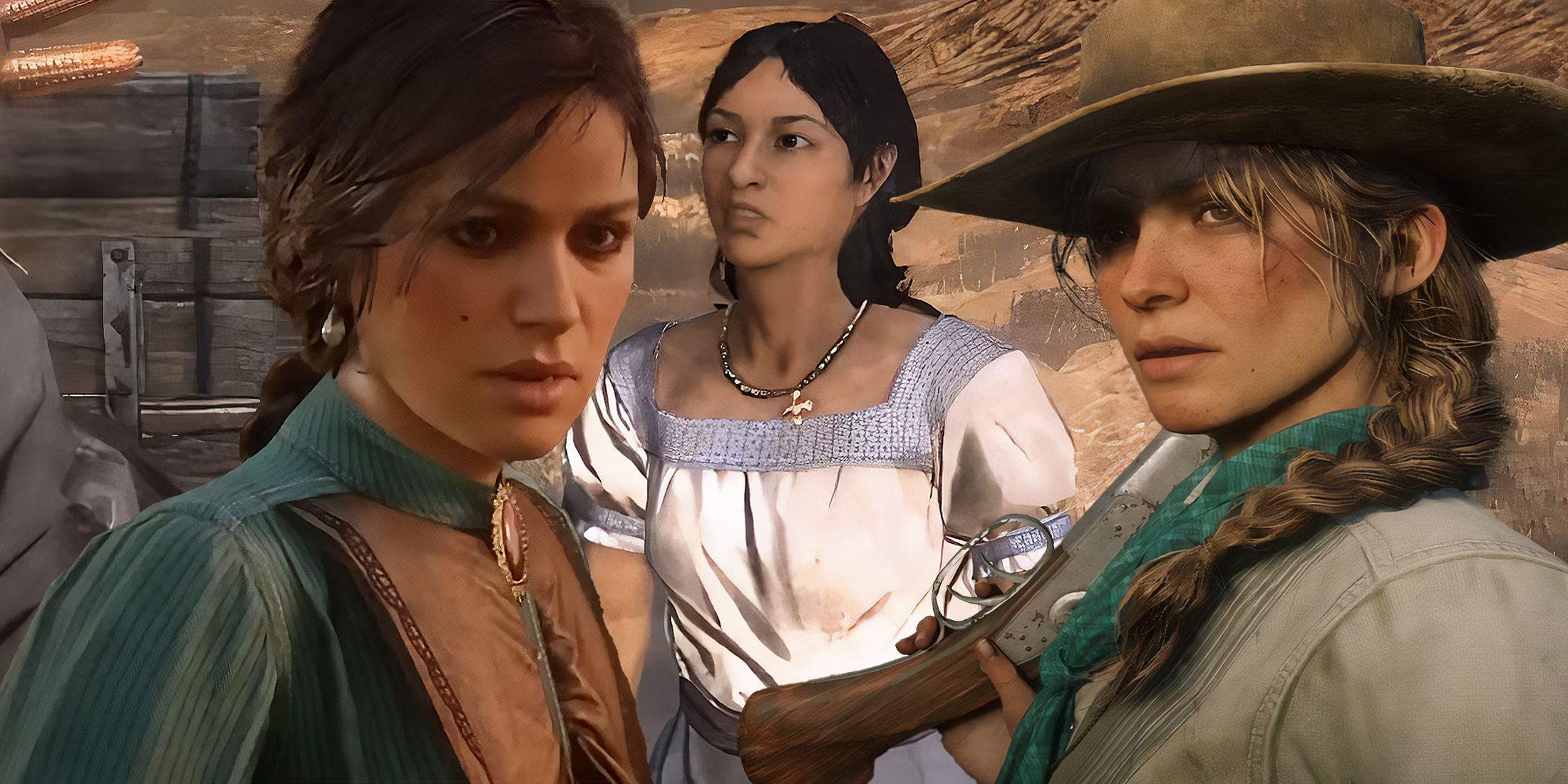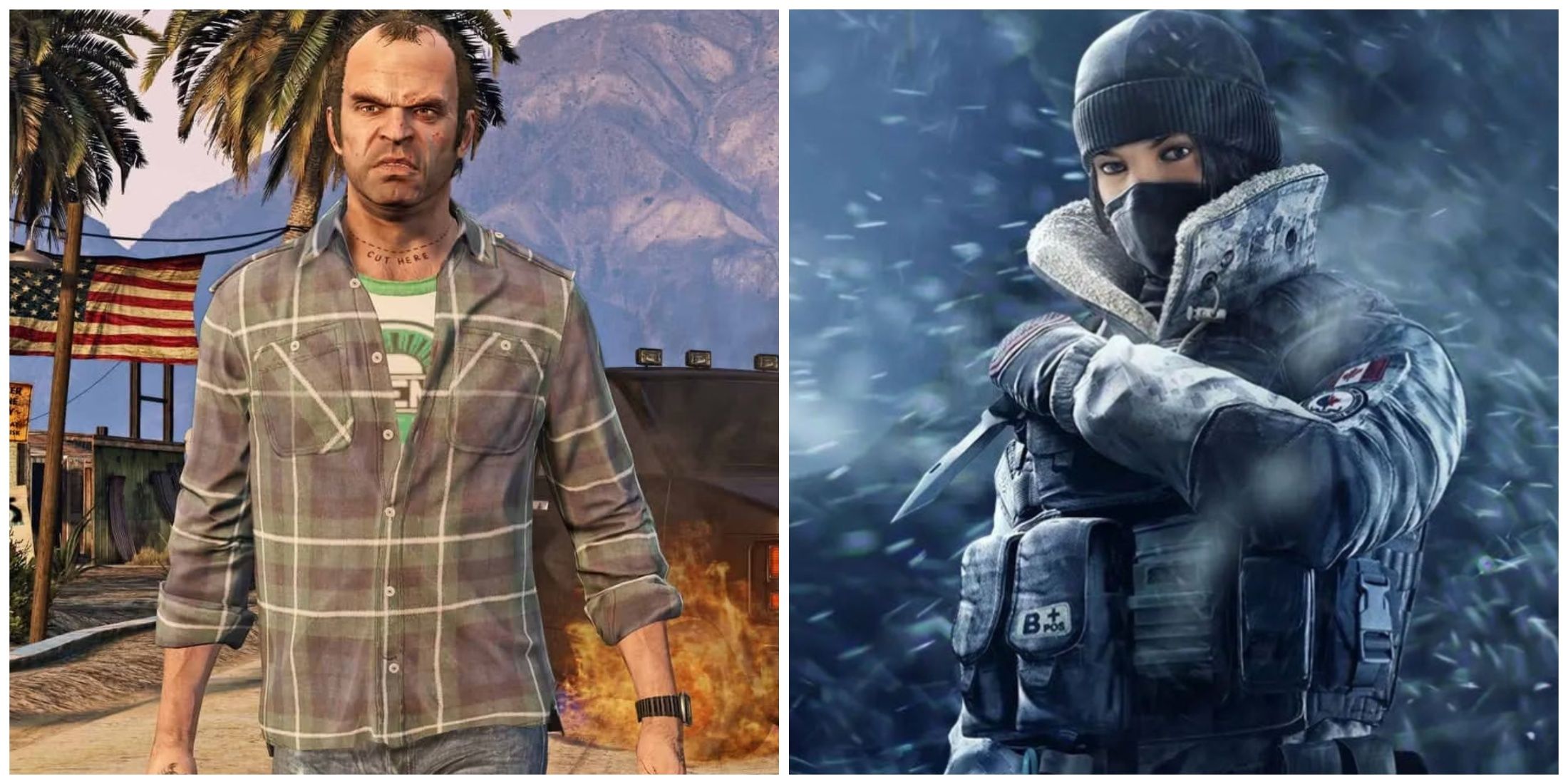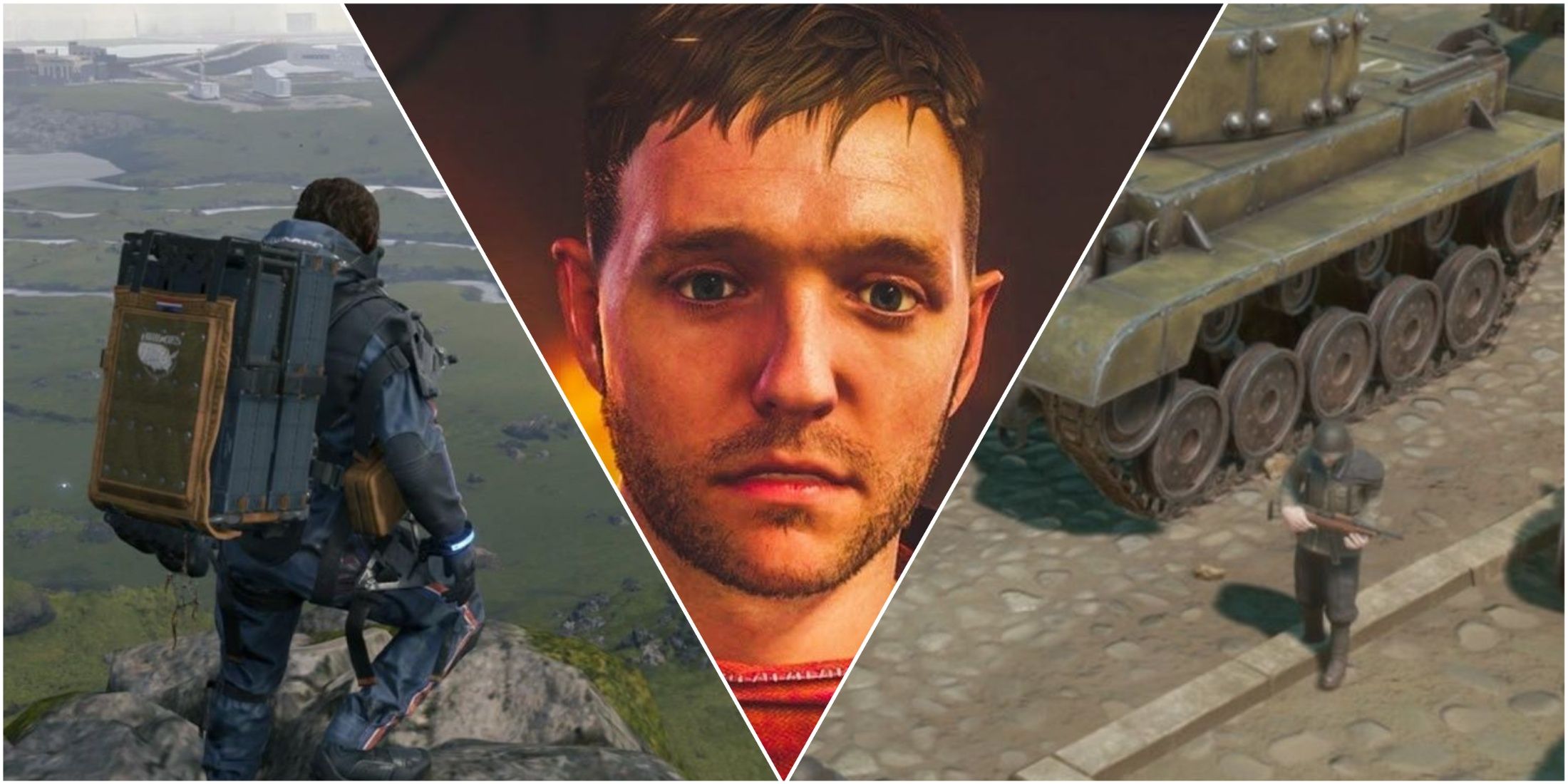Summary
- PTSD can affect anyone, including witnesses or those inflicting trauma, leading to complex character arcs in games.
- Video game characters like Sadie Adler and Martin Walker showcase the impact of PTSD on behavior and decision-making.
- Themes of trauma, survivor guilt, and vengeance shape protagonists like Kratos and Marcus Fenix, showing the lasting effects of war.
Post-traumatic stress disorder, commonly known by the acronym PTSD, is a psychological condition that often affects individuals following a traumatic experience. It comes in many varied forms and affects different people in different ways, but it usually has the central thread of a person reliving the event in their mind. This might come in the form of nightmares, obsessive memories, or heightened emotions triggered by anything the mind associates with the event. One doesn’t even need to be on the receiving end of trauma to develop PTSD. Simply witnessing a traumatic event can be enough. PTSD can even develop in the minds of people who inflict trauma onto others. Because of this, PTSD is commonly associated with soldiers who, by the nature of their job, are subject to trauma both as perpetrators and victims. PTSD has affected people throughout history, although it is only recently that it has really started to gain recognition instead of being dismissed as mere cowardice.

Related
Red Dead Redemption: Best Female Characters, Ranked
The Wild West of the Red Dead Redemption series features some incredible female characters deserving of respect and even fear.
In a fictional context, PTSD can be an effective tool for building a compelling character. After all, it can be a great source of character flaws and personal struggles, and it leaves a lot of room to explore how they are shaped by their experiences. Learning to cope with, face, and/or better understand a traumatic experience can make for an excellent character arc. This can work with any kind of trauma. A survivor on the receiving end may struggle to overcome issues like survivor’s guilt. A witness could struggle with doubt about whether they could have done more to help. Even in the case of perpetrator trauma, their struggle to deal with personal guilt over their actions can be a compelling story. Of course, these categories aren’t mutually exclusive either. A character who goes from victim to perpetrator can add a lot more nuance to their story. Therefore, it’s not a huge surprise that PTSD actually gets a fair bit of representation in video games, among many different characters—heroes, allies, and villains. PTSD can affect anyone and play a big part in who they become.
Spoilers Ahead For The Games Listed
12
Alice Liddell (American McGee’s Alice)
Barely Survived A Fire
American McGee’s Alice
- Released
-
December 5, 2000
- Developer(s)
-
Rogue Entertainment
- Publisher(s)
-
Electronic Arts
American McGee’s Alice and its sequel, Alice: Madness Returns, both gained a reputation for their much more cynical take on Lewis Carroll’s world of Wonderland. The more conventional portrayal involves Alice seeing a talking white rabbit and following it down a hole which leads into the nonsensical fantasy world of Wonderland.
This version does things a bit differently. Instead, the game begins with Alice narrowly surviving a house fire that kills her parents. The traumatic incident leaves her catatonic, and she ends up in a psychiatric ward. Instead of literally wandering into Wonderland, Carroll’s world is used as a metaphor for Alice’s struggle to overcome her personal trauma.
11
Amicia De Rune (A Plague Tale)
Pushed To Extremes To Survive
- Released
-
October 18, 2022
- Publisher(s)
-
Focus Entertainment
- OpenCritic Rating
-
Strong
Both A Plague Tale games aren’t exactly the most optimistic, but a big part of what makes the series so intense is the lengths it pushes protagonist Amicia De Rune. It’s difficult enough to live in Medieval France while the infamous Bubonic Plague is at its peak, not to mention the Hundred Years War is also taking place. However, having to protect a younger brother who also happens to be a carrier with the power to control rats makes things a lot more difficult. Amicia is constantly dragged through the mud, sometimes quite literally. Just in the opening act, she loses her father and home, while witnessing the torture and murder of their family servants. She watches quite a few people being devoured by rats and regularly finds herself having to kill others to survive. At one point, she has to cross a battlefield covered in bodies. And, of course, this is also while being hunted by the Inquisition, who wants her brother so that their leader can get control of the plague himself.
By the events of A Plague Tale: Requiem, Amcia’s PTSD is really starting to show. It starts impairing her ability to think rationally and drives her to make reckless decisions. She is slow to trust and becomes a lot more violent when provoked. Sometimes, she even starts to feel like she isn’t much better than the people attacking her.
Used, Abused, And Discarded
The Metal Gear series often centers around government espionage and military operations of a morally dubious nature, so it’s not surprising that half the cast experiences some form of PTSD. It comes up so often that the fan wiki has an entire page dedicated to characters with PTSD. That said, few go through quite as much trauma (both physically and mentally) as the man known as “Big Boss.” The guy started out in the Korean War, went on to narrowly survive the Bikini Atoll nuclear test, and ended up being manipulated into killing his mentor.
The experience made him relate to other soldiers who experienced similar traumas, feeling that they were being used by their governments and then discarded when they are no longer needed. Ironically, his efforts ultimately turned him into the overarching villain of the series, and in trying to take down the system that ruined his life, he becomes something much worse.
9
Booker Dewitt (BioShock Infinite)
Guilty Of War Crimes
BioShock Infinite took a step away from its predecessors with its protagonist, Booker DeWitt. Instead of a faceless and silent hero, players got a man with a pretty detailed backstory and characterization. It turns out he has a pretty dark backstory involving service in the U.S. Cavalry and the Pinkerton Detective Agency, both of which saw him committing some heinous acts. Anyone familiar with the American Indian wars will know just how cruel the American army could be, and Booker’s performance at the real-life Massacre of Wounded Knee was apparently extreme even by their standards. As a Pinkerton, he would have been hired to break up labor strikes, likely through brute force and intimidation. As a man with a history of violence, he is no stranger to the effects of perpetrator trauma by the start of BioShock Infinite. When players meet him, he’s already dealing with obsessive memories and overwhelming guilt to the point where he feels pretty confident he’s actually the game’s villain.

Related
Best Playable Canadian Characters In Games, Ranked
The realm of gaming is home to an array of great Canadian characters, but not all of them are playable. Here are the best ones who are.
Interestingly, this actually becomes a pretty big part of the story, especially with the reveal that Zachary Hale Comstock is an alternate timeline version of Booker. The point of divergence turns out to be how they processed their trauma after being offered a baptism. Comstock accepted, decided he was absolved of all previous crimes, and embraced Christianity, an act that would lead him to become the “prophet” of Columbia and a multi-dimensional menace. Meanwhile, the Booker controlled by the player refused the Baptism and continued to carry the weight of his guilt, but in doing so, eventually manages to redeem himself.
8
Farah Karim (Call Of Duty: Modern Warfare)
A Victim Of War
Call of Duty: Modern Warfare
- Released
-
October 25, 2019
- OpenCritic Rating
-
Strong
PTSD isn’t something that appears very often in the typical Call of Duty campaign. Usually the emphasis is more on fast-paced action and different types of weapons. However, as part of its effort at realism, the 2019 Modern Warfare reboot took the plunge into exploring how trauma shapes one of its main characters, Farah Karim. The Urzikstani rebel leader has gone through a lot before the game starts, and players even get to experience some of her most traumatic memories in flashback sequences. One sequence from her childhood shows that, over the course of one day, she witnessed an assault on her village, her house collapsing, both her parents being killed, and then was forced to kill three people in self-defense. Then she had to endure years of abuse and torture in Barkov’s prison before being rescued by Captain Price. During the actual campaign, she also has to deal with her own brother turning on her and further violence perpetrated by the terrorist organization Al-Qatala.
Her experiences with PTSD end up affecting a lot of her behavior throughout the game, not only by driving her to fight back, but also how she fights back and perceives others. In particular, she is adamantly against chemical weapons, specifically because of trauma from witnessing what happens to those on the receiving end of them, to the point where she is willing to disown her brother when he suggests using them. It easily makes her one of the most interesting and complex characters in the game. Sadly, Farah was grossly underused in the sequels, preventing any further development of one of the series’ best protagonists.
7
Jason Brody (Far Cry 3)
Pushed To His Limits
- Released
-
November 29, 2012
Violence as a cycle, and its capacity to push people to their worst, is a recurring theme throughout the Far Cry series, so trauma is something of a recurring theme as well. It becomes a big part of Far Cry 3 in the way it affects protagonist Jason Brody. The game literally opens with him being captured by pirates and seeing his brother murdered, which informs much of his later actions. And that’s just getting started.
He also sees his friends being tortured and almost dies several times, plus everything he has to deal with while trying to save Keith from Buck. Citra’s exploitation of his trauma to manipulate him doesn’t help either. Brody spends much of the game walking a fine line between victim and perpetrator trauma, coming from a relatable position but starting to embrace his more primal side as he develops a taste for killing Vaas’s pirates and Hoyt’s privateers. He quickly starts to go off the deep end and lose who he is. Even in the game’s best ending, where he starts to regain control of himself, the story still concludes with the implication that he’s going to be haunted by what he experienced on the island for the rest of his life, and will endlessly fear his killer instincts coming out again.
6
Kratos (God Of War)
Was His Revenge Worth It?
Perhaps not the most obvious one, but the iconic God of War protagonist had to deal with a lot just in the series’ original trilogy, and it made him a pretty terrible person. Being tricked into killing his own family was bad enough, but Kratos’ chaotic rampage of vengeance left a lot of bodies in his wake, many of them innocent people whose only crime was being in the wrong place at exactly the wrong time. Kratos was so blinded by his quest for vengeance he didn’t care about the harm it did to others.
However, what made him really interesting as a character was when the shift towards Norse mythology began to explore just how Kratos was affected by his experiences. He spends a lot of 2018’s God of War struggling with trauma stemming from his previous acts of violence, constantly reliving his previous crimes and growing paranoid about everyone around him. A big part of his character arc becomes learning to cope with his past and trying to move forward as a better person, as well as keeping his son, Atreus, from following a similar path of violence.
5
Marcus Fenix (Gears Of War)
A Lifetime Of War
A big theme of the Gears of War series is humanity’s self-destructive nature, that humans are naturally violent and war is an endless cycle. Since war and trauma tend to go hand-in-hand, it makes sense that the games would want to touch on just how that trauma shapes people. Technically, most of the cast have some form of PTSD stemming from the death and destruction that persists throughout the series, but few went through quite as much as the original protagonist, Marcus Fenix.
Not many soldiers can say they fought in and survived three wars. By the start of the first game, Marcus already gone through the Pendulum Wars, the death of his mother, E-Day, 15 years of the Locust horde trying to wipe out humanity, the apparent death of his father, and incarceration for disobeying orders. By Gears of War 4, Marcus also has to deal with heavy survivor’s guilt after losing his best friend Dom, his wife, and his father’s actual death—and possibly his son’s death in Gears 5 depending on the player’s choices. This is a man who’s somehow managed to carry more trauma than any soldier should be capable of, but he still manages to keep pushing forward, if only because that’s what he’s done his whole life.
4
Martin Walker (Spec Ops: The Line)
Trapped In Delusions Of Heroism
- Released
-
June 26, 2012
- Developer(s)
-
Yager Development
Unsurprisingly, a lot of military shooters tend to overlook or downplay the effects of PTSD in favor of emphasizing fast-paced action and big guns. Being a game specifically designed to subvert the format of military shooters, Spec Ops: The Line puts a lot more emphasis on trauma with its protagonist, Martin Walker; especially perpetrator trauma. A big part of the campaign is actually framed around Walker’s struggle to process everything he goes through, to the point where it becomes more about Walker’s understanding of reality than what’s actually happening.
Ironically, Walker’s efforts to cope with the trauma of everything he sees and does end up being a major part of what brings his heroic status into question. As the plot goes on, particularly after Walker has the lovely experience of discovering he just fired white phospherous at a bunch of civilians, his mind struggles to process everything. His trauma gets particularly bad in this case, as it takes the form of trying to twist reality around him to make his actions seem justified and make him seem like the good guy.
3
Sadie Adler (Red Dead Redemption 2)
Her Husband Is Murdered, Followed By Lots Of Violence
- Released
-
October 26, 2018
- OpenCritic Rating
-
Mighty
This fan-favorite anti-heroine in Red Dead Redemption 2 goes through a lot throughout the game. Before the player even meets her, Sadie Adler has already been robbed by the O’Driscoll gang and watched them murder her husband. By the time she is introduced, Sadie’s being threatened by the Van Der Line gang’s resident psychopath, Micah Bell, who’s accusing her of being an O’Driscoll, and then he sets her house on fire. This very traumatic experience ends up shaping a lot of her character, but that’s just the beginning.

Related
7 Most Idealistic Final Fantasy Characters, Ranked
Much of Final Fantasy’s appeal lies in its idealistic characters, each striving for a better world through bold visions and unwavering optimism.
This could have been a simple character arc of Sadie going from victim to badass, but part of what makes her so memorable is the effort to show how the game’s events affect her mentally. Her hatred for the O’Driscolls is totally understandable, but sometimes it becomes a major character flaw that drives her to make reckless decisions. Even by the epilogue, when she is a successful bounty hunter, she is still dealing with the traumatic experiences of the game’s early events.
2
Sayla (Far Cry Primal)
A Survivor Of Genocide
- Released
-
February 23, 2016
- OpenCritic Rating
-
Strong
Violence leading to violence is a common theme in the Far Cry series, and that continues with Far Cry Primal, a game that centers around a scattered Mesolithic tribe coming together and taking revenge on their enemies. Several of the Wenja have understandable reasons to fear and hate the rival Udam and Izila tribes, but the one who gets hit the hardest is Sayla. She was a child when her village was hit by the Udam, and watched the massacre of her family. Her trauma then manifests in the form of hearing their screams.
Unfortunately, she lives in the Stone Age, a full 11,800 years before the advent of psychology, let alone any proper understanding of PTSD. Without any way to understand her condition, Sayla’s PTSD leads to some unhealthy habits, such as a compulsion to collect Udam ears and a stern hatred for the rival tribe that often borders on psychotic. It makes for a pretty dark character.
1
Zara Ghufran (Battlefield 1)
Saw Her Home Destroyed By The Ottomans
- Released
-
October 21, 2016
- Publisher(s)
-
Electronic Arts
- OpenCritic Rating
-
Mighty
Battlefield 1 takes place during the First World War, a conflict in which PTSD (known then as “Shell Shock”) was rampant among combatants on all sides. It doesn’t take a genius to figure out why. Technology was advancing faster than armies could keep up, death tolls that would have been unimaginable a decade earlier piled up, tanks and airplanes were introduced to the battlefield, and it also brought the first use of chemical warfare. Therefore, it makes sense that Battlefield 1 would try to address the issue in its story campaign.
It actually comes up a few times. The opening sequence involves a survivor of the war experiencing a flashback to a brutal battle in which most of his unit was killed. However, it becomes even more apparent during the final campaign story, which deals with the famous Lawrence of Arabia. Although the game initially teases that the player is Lawrence himself, it turns out they are actually playing as a Beduin woman named Zara Ghufran. Contrary to what the 1962 film would have viewers believe, there were in fact women involved in his campaign.
Zara is playable for three missions where she helps Lawrence take on an armored train, but during that time players also get some insight into why she holds so much disdain for the Ottoman Empire. It turns out that it’s quite personal in her case, with the implication that the armored train destroyed her home village. A lot of that trauma is very clearly present when she almost kills a captured Ottoman commander out of pure anger. It is unfortunate that she is only playable for such a short campaign. A longer one exploring her part in Lawrence’s adventures could do a lot more to dive into her PTSD.

MORE
5 Open-World Games Where You Aren’t Overpowered
When a playable character isn’t an overpowered chosen one, the consequences of open-world games feel more tangible.














